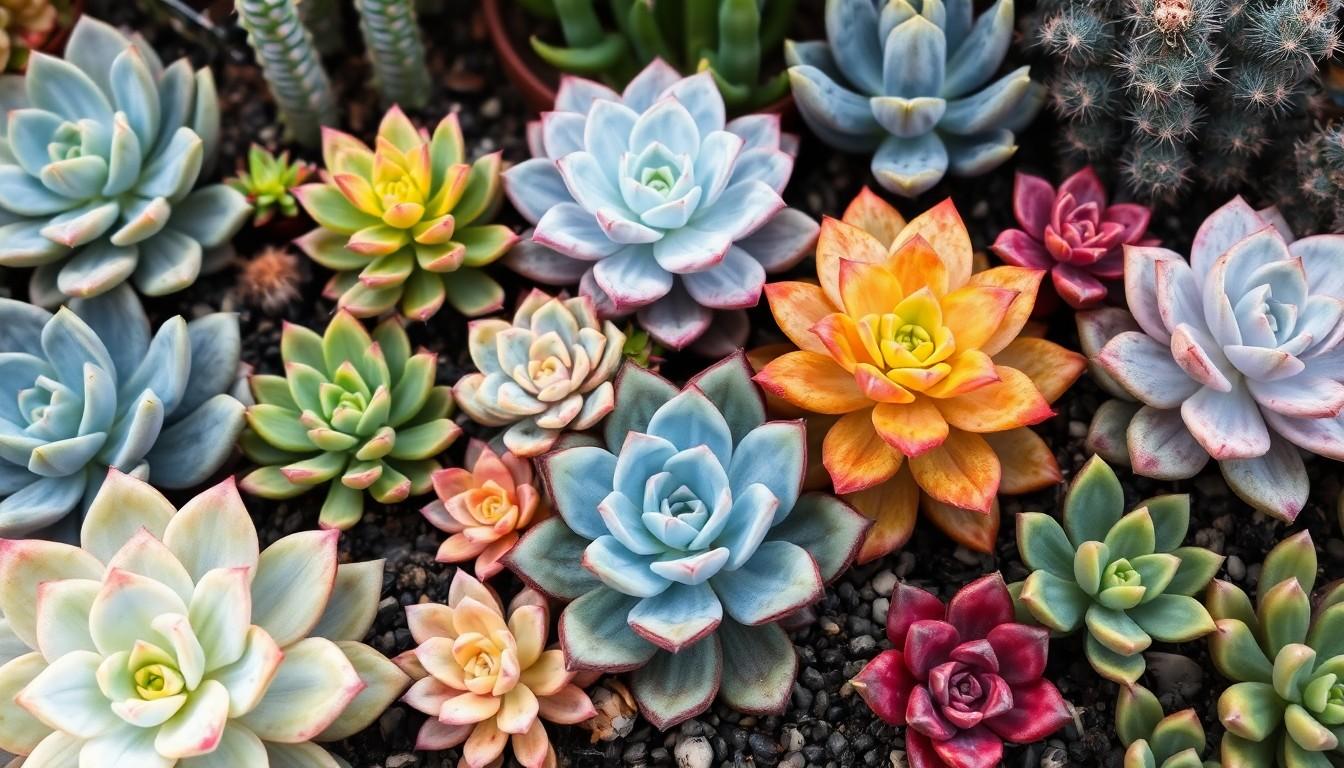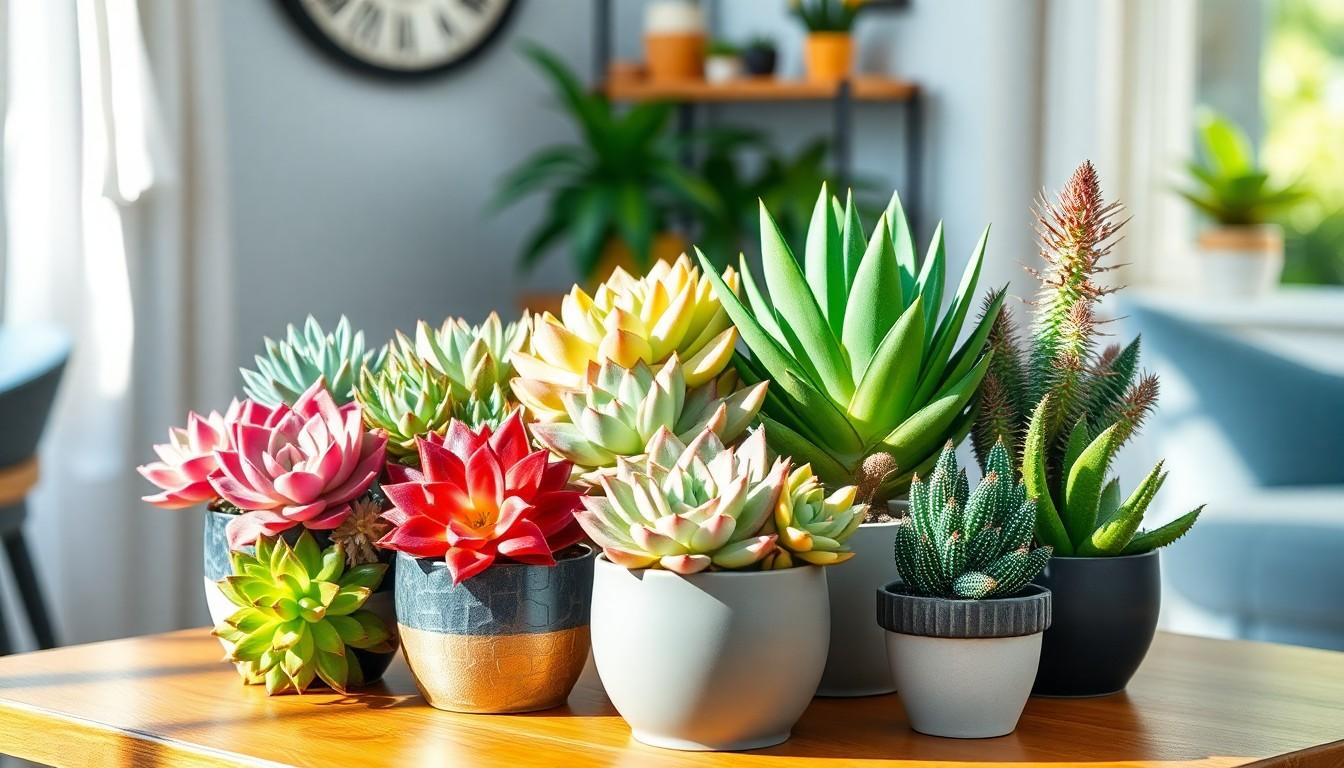Succulents are like the cool kids of the plant world. They’re low-maintenance, stylish, and come in a dazzling array of shapes and colors. Whether you’re a seasoned green thumb or someone who’s accidentally turned a cactus into a paperweight, succulents offer a delightful way to add life to any space without demanding too much attention.
From the plump and playful Echeveria to the quirky and spiky Aloe Vera, there’s a succulent for every personality. These hardy plants not only thrive on neglect but also bring a splash of personality to your home or office. Get ready to explore the fascinating world of succulents and discover which ones might just become your new leafy companions. After all, who wouldn’t want a plant that’s as resilient as it is charming?
Overview of Succulents
Succulents encompass a variety of plants known for their fleshy leaves and stems. These adaptations help them store water, making them ideal for dry environments. They thrive in sunny locations and require minimal watering, contributing to their popularity among gardeners.
Diversity among succulents is vast. Some common types include:
- Echeveria: Recognized for its rosette shape and vibrant colors, Echeveria adds visual interest to any collection.
- Aloe Vera: Valued for its medicinal properties, Aloe Vera also offers unique, spiky leaves and a striking appearance.
- Jade Plant: Often associated with good luck, the Jade Plant features thick, oval leaves and a bushy growth habit.
- Haworthia: Small yet resilient, Haworthia varieties showcase fascinating patterns and textures.
- Agave: Known for its architectural form, Agave can reach impressive sizes and often produces stunning flower spikes.
These plants’ adaptability makes them suitable for various environments, including indoor settings, outdoor gardens, and even terrariums. Succulents benefit from well-draining soil and a pot with drainage holes to prevent root rot.
In terms of care, overwatering leads to most problems for these plants. Observing soil moisture levels before watering ensures their health. Many succulents also display interesting growth patterns, such as stretching towards light or developing offsets.
Using a variety of succulents in arrangements can create captivating displays. Grouping different species allows unique textures and shapes to complement each other. Overall, the variety, beauty, and ease of care make succulents a favorite among plant enthusiasts of all levels.
Types of Succulents

Succulents come in various types, each exhibiting unique features. The following categories highlight the diversity among these resilient plants.
Fleshy Leaf Succulents
Fleshy leaf succulents, such as Echeveria and Sedum, display thick and fleshy leaves designed to store water. These plants often feature rosettes, with leaves arranged in a circular pattern. Colors range from vibrant greens to blues, pinks, and even purples. Echeveria needs bright light and well-draining soil to thrive. Sedum offers a wide variety of shapes and sizes, making it popular for gardens.
Stem Succulents
Stem succulents include species like Cacti and Jatropha, characterized by their thick, fleshy stems. Cacti often have spines instead of leaves, adapting them to retain moisture in arid climates. These plants also vary in size, from small decorative types to towering specimens. Jatropha, known for its striking shapes, often showcases vibrant flowers alongside its succulent stems. These plants prefer direct sunlight and require minimal watering, making them perfect for busy gardeners.
Root Succulents
Root succulents, such as Dioscorea and Cyphostemma, store water primarily in their underground tuberous roots. The unique growth habits of these plants result in striking above-ground appearances. Dioscorea features heart-shaped leaves, while Cyphostemma showcases thick, woody stems and broad leaves. Root succulents often thrive in well-draining soil and require careful watering, as their roots can rot if overwatered. These plants offer an eye-catching option for succulent collectors.
Popular Succulent Varieties
Many succulent varieties offer distinct characteristics and appeal, making them popular choices for enthusiasts. Each type showcases unique features and care requirements.
Echeveria
Echeveria thrives in various colors and shapes. These fleshy leaf succulents form striking rosettes, often displaying hues like pink, blue, and green. With proper light and minimal watering, Echeveria can flourish indoors or outdoors. The rosettes, surrounded by vibrant leaves, create an eye-catching display. Ideal for well-draining soil, Echeveria requires pots with drainage holes to promote healthy growth. Known for adaptability, these succulents are perfect for beginners and seasoned gardeners alike.
Haworthia
Haworthia stands out with its unique, architectural forms. Characterized by thick, fleshy leaves, this succulent showcases distinct patterns that vary among species. From dark green to striped varieties, Haworthia plants add visual interest to any collection. These plants prefer bright, indirect sunlight and can cope with lower light levels. Watering should be minimal, allowing the soil to dry out between sessions. Haworthia’s resilience and low-maintenance nature make it a favorite for indoor spaces and succulent arrangements.
Aloe Vera
Aloe Vera serves numerous benefits beyond its aesthetic qualities. Recognized for its medicinal properties, this succulent has thick, fleshy leaves containing a soothing gel. The plant thrives in bright, indirect sunlight and requires infrequent watering. Its cylindrical leaves can grow 24 to 36 inches tall, creating a striking focal point. Aloe Vera enjoys well-draining soil, helping prevent root rot. Many people keep Aloe Vera in their homes for both decorative and health-related purposes, making it a versatile addition to any succulent collection.
Caring for Succulents
Caring for succulents involves understanding their unique needs. These plants thrive with the right watering and lighting conditions.
Watering Guidelines
Watering succulents requires attention to soil moisture levels. Typically, they thrive with infrequent watering, usually every 1-2 weeks. Allow the soil to dry out completely between watering sessions. Overwatering remains a common issue that leads to root rot. Use pots equipped with drainage holes to facilitate excess water drainage. Monitoring changes in a plant’s appearance, like wilting or browning leaves, indicates a need for adjustment in the watering schedule. During the winter months, many succulents enter dormancy and require even less water.
Light Requirements
Light significantly impacts the health of succulents. Bright, indirect sunlight promotes their growth and vibrancy. Place them near south or west-facing windows for optimal exposure. Extended periods in direct sunlight may cause leaf scorch, leading to unsightly marks. However, some succulents, such as Echeveria, thrive under full sun. Regularly rotating pots ensures even exposure to light, contributing to balanced growth. If natural sunlight is insufficient, consider using grow lights to support these resilient plants.
Conclusion
Succulents offer an enchanting blend of beauty and resilience that can elevate any space. Their diverse forms and colors invite creativity in home and garden design. With minimal care requirements and a forgiving nature, these plants are perfect for anyone looking to add life to their surroundings.
Whether choosing Echeveria for its stunning rosettes or Aloe Vera for its practical benefits, each succulent brings its own charm. By understanding their specific needs and characteristics, enthusiasts can cultivate a thriving collection. Embracing the world of succulents not only enhances aesthetics but also fosters a deeper connection with nature.

